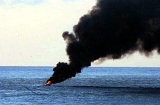
Action of 18 March 2006
Encyclopedia
.jpg)
United States Navy
The United States Navy is the naval warfare service branch of the United States Armed Forces and one of the seven uniformed services of the United States. The U.S. Navy is the largest in the world; its battle fleet tonnage is greater than that of the next 13 largest navies combined. The U.S...
were attacked by pirates. The U.S. ships were part of Combined Task Force 150
Combined Task Force 150
Combined Task Force 150 is a multinational coalition naval task force working under the 25 nation coalition of Combined Maritime Forces and is based in Bahrain established to monitor, inspect, board, and stop suspect shipping to pursue the "War on Terrorism" and in the Horn of Africa region ...
.
Background
By 2006 the lack of any government-controlled naval authority along the SomaliSomalia
Somalia , officially the Somali Republic and formerly known as the Somali Democratic Republic under Socialist rule, is a country located in the Horn of Africa. Since the outbreak of the Somali Civil War in 1991 there has been no central government control over most of the country's territory...
coast was taking its toll. Pirate gangs controlled by local warlords started to capture passing merchant ships in an attempt to gain funding by ransoming the ships and their crews. As the raids became successful, the pirates became bolder. They began seizing UN aid ships, and even attacked a cruise liner attempting to capture it for ransom. The U.S. and Coalition vessels from Combined Task Force 150 began actively pursuing pirate vessels in an attempt to deter the attacks.
The battle
On 18 March the destroyer intercepted a suspicious ship, a large diesel skiff towing two small gasoline-powered "attack" skiffs 25 nautical miles (46 km) off the Somali coast. USS Gonzalez first noticed the common pirate profile of a diesel boat towing smaller skiffs and, with USS Cape St. George closing from 40 miles away, trailed the suspects until dawn. Shortly before sunrise, the two American ships each sent a pair of rigid-hulled inflatable boatRigid-hulled inflatable boat
A rigid-hulled inflatable boat, or rigid-inflatable boat is a light-weight but high-performance and high-capacity boat constructed with a solid, shaped hull and flexible tubes at the gunwale. The design is stable and seaworthy...
s with specially trained boarding teams to investigate. The boats' boarding attempt was aborted when the pirates opened fire on them from extremely short range, and they returned fire and withdrew.
The pirates chased the boarding team, then opened fire upon the Navy ships with RPGs and other small arms
Small arms
Small arms is a term of art used by armed forces to denote infantry weapons an individual soldier may carry. The description is usually limited to revolvers, pistols, submachine guns, carbines, assault rifles, battle rifles, multiple barrel firearms, sniper rifles, squad automatic weapons, light...
. Too close for major weapon systems, the two American ships returned fire with small caliber guns. The larger pirate skiff was soon set on fire by a 25MM tracer round fired from the USS Cape St. George hitting and setting ablaze a 55-gallon fuel drum, and burned to the waterline. The two small skiffs were engaged and surrendered to USS Cape St. George upon seeing the larger skiff with all their fuel in flames. By the time the action was over at least one pirate was killed (only one body was recovered from one of the remaining small skiffs), and 12 (including 5 wounded) pirates were captured. A spokesman for the Somali pirate militia in Hardhere claimed there were 27 pirates that had gone to sea to act as "coastguardsmen" for the largely lawless state. Cape St. George received minor superficial damage but no US forces were injured.
Aftermath
After the action was over a Dutch fast combat support ship, the HNLMS AmsterdamHNLMS Amsterdam (A836)
HNLMS Amsterdam is one of two replenishment ships serving with the Royal Netherlands Navy. The Amsterdam entered service in 1995....
, provided medical assistance to the wounded and the two US ships continued on their mission. The US Government chose not to prosecute the captured men for piracy, and repatriated them over a period of several months, some requiring advanced medical care aboard US and Coalition warships due to the injuries they received during the action.

